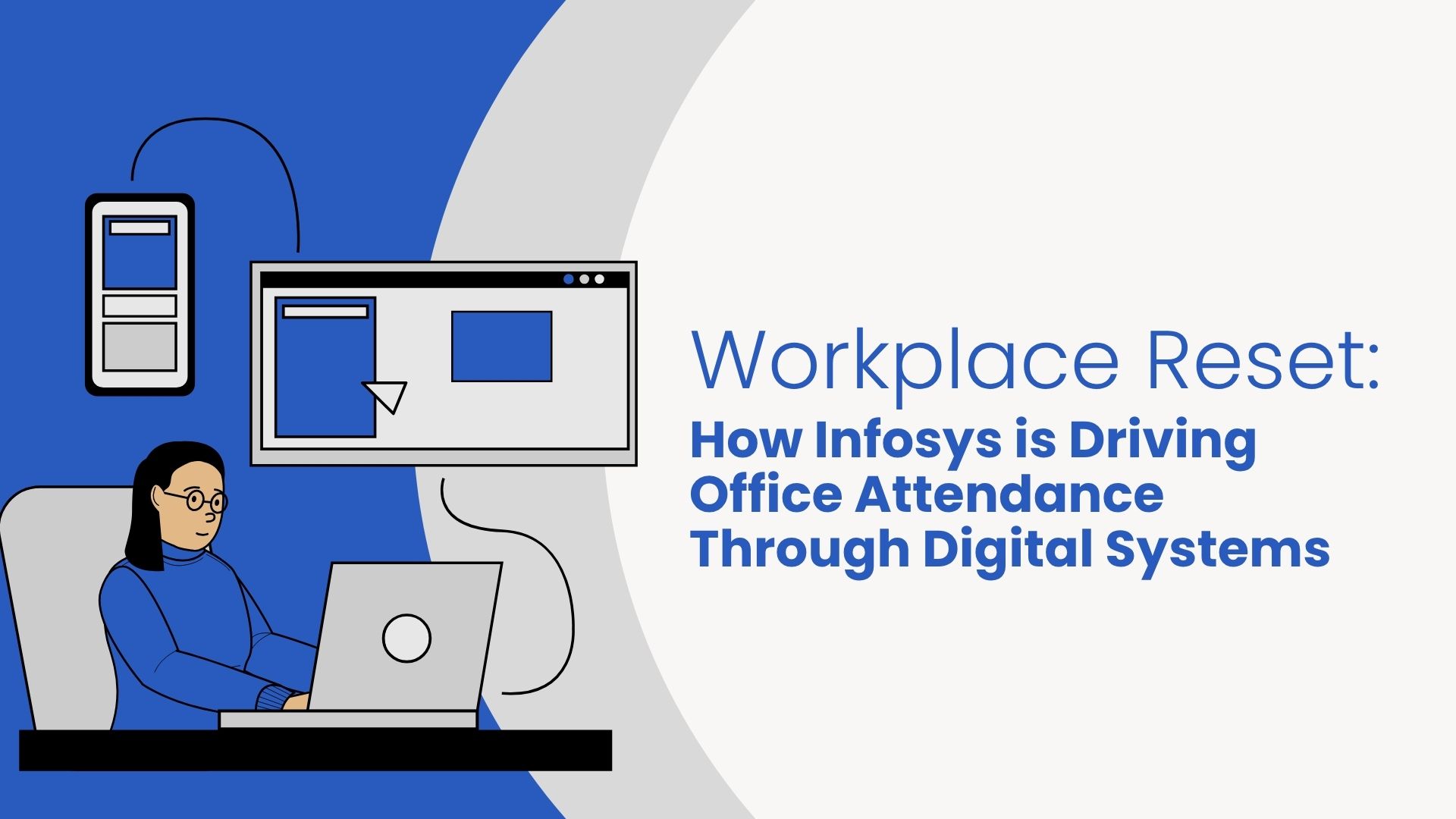In the evolving landscape of hybrid work, many major companies are trying to strike a balance between remote flexibility and in-office collaboration. Infosys, a leading IT firm in India, has recently implemented a strict measure requiring employees to work from the office for a minimum of 10 days each month. This decision, referred to as a “system intervention,” has sparked discussions across corporate India. One of the key tools in enforcing this Mandate is the implementation of an employee attendance app designed to track and manage in-office presence. This blog delves into Infosys’ approach, the role of technology in monitoring employee attendance, and the implications of such digital interventions on the modern workforce.
Understanding the 10-Day Mandate
Infosys has issued internal guidelines requiring employees to report to the office for at least 10 days every month. While this isn’t a full return to pre-pandemic office life, it is a step towards rebuilding office culture. The decision stems from the need to enhance collaboration, mentor junior employees, and foster innovation — aspects that remote work has somewhat hindered. To ensure this Mandate is effectively implemented, Infosys has adopted a system-level change where employee presence is monitored using an employee attendance app.
The Role of the Employee Attendance App
Infosys has introduced an employee attendance app that integrates seamlessly with its internal HR systems. This app helps monitor daily check-ins, log attendance data, and generate analytics that support managerial oversight. The employee attendance app acts as the central tool in verifying compliance with the 10-day office attendance requirement. Employees use the app to mark their presence via mobile check-in, Wi-Fi login, or biometric confirmation, depending on the system linked to their office premises. The app also notifies managers of absenteeism, exceptions, and attendance trends.
Why System Intervention Was Needed
Post-pandemic work culture has seen a significant shift in employee expectations. With many employees preferring remote work or hybrid flexibility, companies are finding it difficult to standardize attendance rules. Infosys’ leadership felt that a system-level enforcement was necessary to ensure fairness and accountability. Instead of relying solely on manager discretion or voluntary attendance, Infosys implemented the employee attendance app as a formalized intervention. This allows HR and leadership to track, report, and manage attendance consistently across departments and locations.
Employee Reactions to Digital Monitoring
The implementation of the employee attendance app has received mixed reactions. While some employees understand the need for structured attendance in a hybrid model, others view it as a loss of autonomy. Concerns have been raised about micromanagement, data privacy, and the broader implications of digitally tracked data. However, Infosys has clarified that the employee attendance app does not collect personal data beyond attendance metrics. The goal is not surveillance but structured engagement and productivity through meaningful in-office presence.
Benefits of Using an Employee Attendance App
Infosys’ decision highlights the growing importance of digital tools in managing hybrid workforces. Here are some of the key benefits of using an employee attendance app:
- Centralized Tracking: Real-time attendance data across all office locations.
- Automated Reports: Simplified generation of monthly attendance compliance reports.
- Employee Transparency: Employees can review their in-office days and plan accordingly.
- Policy Enforcement: Ensures fair and uniform adherence to policies across departments.
For large organizations like Infosys, an employee attendance app is not just about monitoring — it’s a strategic tool for managing workforce engagement and productivity.
Encouraging Office Culture Through Technology
One of Infosys’ goals in enforcing the 10-day Mandate is to reignite office culture. The company believes that casual interactions, in-person brainstorming sessions, and team rituals are essential for driving organizational growth. By aligning the employee attendance app with its cultural goals, Infosys is blending digital efficiency with human connection. Some office campuses have begun organizing team lunches, workshops, and informal meetups to make office visits more engaging and meaningful. The employee attendance app helps HR teams coordinate these events by analyzing attendance patterns and in-office presence by the department.
Impact on Productivity and Collaboration
Initial feedback from team leaders suggests that regular in-office interactions have improved cross-team collaboration. Employees, especially new joiners and trainees, benefit from face-to-face mentoring and structured feedback sessions. The employee attendance app plays a crucial role in this process by ensuring teams align their in-office days to maximize joint working time. Calendar syncing and attendance scheduling features within the app further assist in effective team planning.
How Infosys Is Addressing Privacy Concerns
Infosys has emphasized transparency in the use of the employee attendance app. The app is designed only to track office check-ins and not personal location data. Attendance data is stored within Infosys’ secure IT infrastructure, adhering to internal privacy protocols. The company has also opened feedback channels for employees to share concerns about the app. Regular internal audits ensure that data use complies with corporate ethics and national data protection guidelines.
Challenges in Implementation
Despite the benefits, enforcing system-level attendance isn’t without hurdles. Some challenges Infosys has faced include:
- Technical Glitches: Ensuring the employee attendance app works uniformly across all office locations.
- Remote Project Assignments: Some teams still operate remotely due to client requirements.
- Individual Preferences: Not all employees are ready to switch back to regular office visits.
Infosys is addressing these by refining app features, offering waivers in exceptional cases, and gradually transitioning teams to hybrid schedules.
Long-Term Implications for Corporate India
Infosys’ approach could set a precedent for other IT companies grappling with hybrid workforce management. The employee attendance app, as used by Infosys, might inspire other organizations to invest in similar tools. By blending system intervention with flexibility, Infosys is trying to redefine post-pandemic workplace expectations. The move also signals a broader shift towards structured hybrid models, where employee autonomy coexists with organizational accountability.
What Makes Infosys’ Strategy Stand Out?
Unlike blanket return-to-office mandates, Infosys has taken a measured approach. Requiring 10 days in the office offers a balanced approach between maintaining flexibility and providing the necessary structure. The use of an employee attendance app ensures objective tracking without constant manager oversight. Infosys is also leveraging the data generated through the employee attendance app to improve workspace utilization, optimize resource planning, and measure employee engagement more effectively.
Main Highlights
- Infosys has mandated a 10-day in-office work rule to boost collaboration and culture.
- A system intervention has been implemented using an employee attendance app for seamless tracking.
- The app supports scheduling, attendance logging, reporting, and compliance monitoring.
- Employee reactions are mixed, but Infosys is ensuring privacy, transparency, and adaptability.
- The move may influence how other IT firms shape their hybrid work policies.
As the future of work continues to evolve, companies must adopt tools and policies that align with their culture and business goals. Infosys’ use of a system intervention, powered by an employee attendance app, is a clear step toward a structured hybrid work approach. By doing so, Infosys aims to maintain employee flexibility while ensuring that in-office collaboration, culture, and productivity are not lost in the shift. Whether other companies will embrace a similar strategy is still uncertain. Still, one thing is clear — in the new standard, digital tools like the employee attendance app will be central to managing workplace transformation.
Sources:
- Emery Bowles – https://emerybowles.com/time-doctor-review
- Connecteam – https://connecteam.com/reviews/time-doctor/





